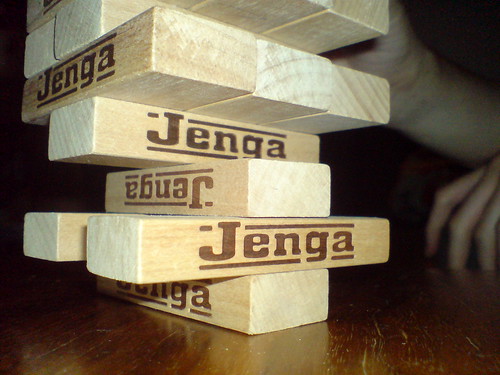Reflection on a talk by Jaime Griesemer: “Design in Detail: Changing the Time Between Shots for the Sniper Rifle from 0.5 to 0.7 Seconds for Halo 3.”
“Balance is longevity.”
“Crank the Flow Knobs.”
“It’s impossible to balance without a solid build.”
Long and a little dry, but so valuable. Here is a designer walking us through the real experience of balancing details in a triple-A game, of all the principles and heuristics and philosophies and gut feelings involved. I pulled a handful of fantastic insights from this talk, and I think there are many more that I missed because I was focused on these.
“Balance is longevity.” This is such a simple idea, but so useful. Griesemer uses Jenga as an example: “Your turn ends ten seconds after you place your brick.” Something is balanced if it will stay for a long time after you set it – in Halo, this meant the sniper rifle stayed interesting and useful for years after the game was released, but not more interesting and useful than other weapons. When balancing an element in a game, you are looking to make players using that element as long as possible.
“Crank the Flow Knobs.” Why not? When you’ve identified key characteristics of an element, take them to 100%, or infinity, or whatever their maximum value is. This seems like a spin on the concept of simplicity and transcendence, on a micro-scale. It also helps obviously set elements apart, and gives them clear roles. Speaking of…
What’s my role? Every element in your game has a role to play. You should clearly state the role of each element as early as your paper prototype, because this tells you which attributes to “crank” and becomes the baseline for all your balancing down the road. The team knew they couldn’t mess with the sniper rifle’s range or power because that would be in violation of its role.
“It’s impossible to balance without a solid build.” Another thought that should be obvious, but is probably violated all the time. Balance issues are not bugs, and when there are bugs it’s too hard to balance. Griesemer suggests that balancing too early is more harmful than balancing too late. I’m not sure about that, but this does remind me of Brandon Boyer’s Less Talk More Rock; not in the sense of interactivity outweighing story, but in the re-ordering of priorities: Build it, then talk. Balancing is talk. Build it first! Rapid prototyping! ETC’s favorite principle!
